Homeowners like you often are torn between hiring a professional to handle lawn care services versus taking a do-it-yourself (DYI) approach. Each option has it benefits and draw-backs. In this article, we’ll focus on the DYI approach to leveling your lawn.
Dips, Bumps and Lawn Potholes
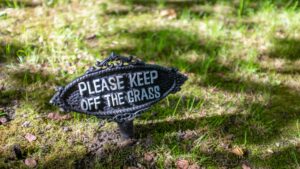 Call it what you want but areas of unevenness in your lawn can be both a nuisance and a danger. Cutting your grass across bumpy turf produces unsightly results as some grass remains uncut as the mower dumps up and drops down. Dips in your lawn tend to leave grass looking scalped. Then there’s the challenge of trying to mow in a straight line. The result is a lawn that looks like it was mowed while wearing a blindfold! But dips and raised spots in the lawn can also be a safety hazard that can lead to trips and falls.
Call it what you want but areas of unevenness in your lawn can be both a nuisance and a danger. Cutting your grass across bumpy turf produces unsightly results as some grass remains uncut as the mower dumps up and drops down. Dips in your lawn tend to leave grass looking scalped. Then there’s the challenge of trying to mow in a straight line. The result is a lawn that looks like it was mowed while wearing a blindfold! But dips and raised spots in the lawn can also be a safety hazard that can lead to trips and falls.
Causes of Uneven Lawns
There are a number of things that can leave your lawn lump and bumpy.
- Frost Heave
The annual freeze and thaw cycle heaves up and sinks areas of the lawn. This is commonly referred to as frost heaving. Frost heaving usually occurs when your soil is subjected to on and off periods of freezing and thawing. This results in both high and low spot in your lawn.
- Drainage Issues
Leaks in underground pipes will erode the soil and result in a soil depression. Poorly directed downspouts or sump pump discharge hoses can quickly erode the soil at ground level. There are several options for dealing with this including downspout directors or extenders or the creation of an attractive and functional dry-creek bed.
- Pests
Grubs can not only damage your turf, but they can disrupt the underlying soil layer. Grubs also attract wildlife that dig up your lawn looking to grab a quick meal of these pests. Moles, voles and the like tunnel underneath your grass which can lead to strips of heaved or depressed strips of uneven lawn.
- Broken sprinkler lines eroding the soil beneath the surface.
- Heavy equipment and car traffic across the lawn can quickly lead to ruts and deep turf damage.
- Construction projects such as a driveway or pool installation can leave void spots in the lawn that will require your attention.
- Improper Grading – when your yard is not properly slopped away from your house and its foundation.
Be certain to address the underlying cause however it applies to your situation so the problem doesn’t occur again in the future. Whatever the cause of your uneven lawn, there is a reasonably easy DYI solution.
Why You Should Level Your Yard![]()
Still, the main complaint we hear from homeowners is that an uneven yard is difficult to mow. In addition to all the problems we previously mentioned, an uneven lawn is also a trip and fall hazard. Consider these benefits of leveling your lawn:
- Leveling will help insure that the right amount of water reaches all turf and plants while avoiding muddy spots and water waste.
- Leveling leads to easier lawn maintenance. Your mower or spreader won’t get stuck on the peaks and valleys.
- It much easier to rake up the fall leaves.
- It’s safer for both adults and children as you greatly lessen the trip and fall risk.
- A level lawn leads to a lush lawn that looks great and is much easier to maintain.
What Material is Best for Lawn Leveling?
First, consider the underlying problem:
- For grading and back-filling of areas with a depth of greater than 3 inches, topsoil is your best bet. For depths greater than that consider fill dirt before the topsoil. Tim Wallace Landscape Supply can deliver up to 12 cubic yards of topsoil at a time. Just call for details.
- For leveling and for low spots in the lawn requiring less than 3 inches of material – topdressing of 50% pulverized black dirt and 50% fine sand is the best option. At Tim Wallace Landscape Supply our topdressing mix is mechanically blended in 4 stages to insure a loose, easy to spread product.
What Is Topdressing for Lawns?
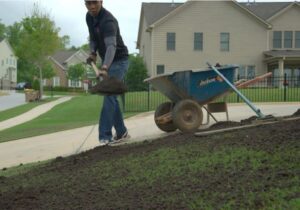 For optimal results, topdressing needs an organic material. Topdressing with good-quality topsoil combined with fine sand is ideal for leveling and for lawn growth.
For optimal results, topdressing needs an organic material. Topdressing with good-quality topsoil combined with fine sand is ideal for leveling and for lawn growth.
If you’ve ever wondered how and why grass on golf courses is so rich and green, topdressing with sand is a major reason. Sand is a great asset because it spreads simply and levels a surface easily. It also enhances soil structure and increases root-zone porosity to support deep roots with good infiltration of water and air.
Where black dirt will dry out, 50/50 sand and topsoil topdressing will keep the soil moist and loose. In addition, while material such as compost or manure will add beneficial microbes and organic matter to the soil, a healthy turf will typically already have its own microbial ecosystem as it produces its own organic matter as thatch.
- Topdressing is a fresh, richly prepared mix that you apply to the surface of your lawn for either seeding it or providing a reinforcing bed layer to lay new sod.
- A good mix should closely resemble your existing soil’s composition. The new materials you add will form part of what’s referred to as the root zone, which is the soil where roots grow best, so they need to blend well with the soil that’s already there.
- Lawn leveling with topdressing works best when you’re filling areas of no more than 3 inches in depth.
- The lawn topdressing is most effective when it is applied in a layer of ½” or less. Overseeding combined with topdressing can really help repair and renovate your lawn.
When you add topdressing for the lawn, you help:
- replenish lost or consumed nutrients by adding organic matter to the topsoil
- reduce the need for fertilizer as a result of the organic nutrients
- improve air circulation for grass and plant roots
- enhance soil structure for growth
- contribute to greater water retention (the topdressing blocks and slows evaporation)
- make the top grass layer softer, thicker and more bouncy
That’s a lot of benefits from a modest amount of material. Beyond smoothing the surface of your lawn, topdressing can reduce build-up of thatch by supporting decomposition.
When Should I Topdress My Lawn?
The best time to topdress the lawn is right before an anticipated growth spurt, which will usually take place in early or middle spring, the end of summer or the middle of autumn. Avoid applying topdressing in summer and winter.
How to Topdress a Lawn
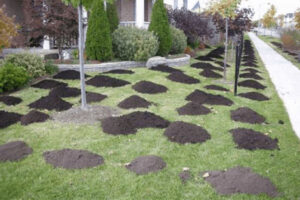 Lawn topdressing can be applied with a pail or shovel and a rake. You might also need a wheelbarrow to move your topdressing mix.
Lawn topdressing can be applied with a pail or shovel and a rake. You might also need a wheelbarrow to move your topdressing mix.
You’ll want to add your topdressing on a dry day, so if it’s rained recently, wait a few days before you get started. The lawn should be mowed short as well as be dethatched or core aerated if the thatch is deeper than your nail when you insert your finger. Remember too that the topdressing should not be any deeper than 1” from ground level up. This insures that your existing grasstops are still visible through the newly added topdressing.
You can approach the application in three passes. In the first, lump the fresh mix around the yard so that it appears dotted with molehills every few feet. On the next pass, spread the lumps evenly and break any clumps into small bits.
On the last pass, rake or brush the grass so the mix falls through the grass and the blades peek through an even depth.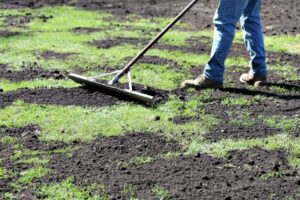
You can then lightly water the lawn to help the topdressing trickle even further to ground level. Wait at least three or four days before mowing the lawn again.
Be careful not to place too much topdressing at the risk of killing the grass. It’s better to topdress twice with half the amount than once with a larger quantity. Also don’t topdress the lawn more than once every three weeks.
As we touched on earlier, remember that it’s important for the topdressing to be compatible with the existing soil’s composition.
If you’re planning on over-seeding your lawn, do it right before you spread your topdressing. Be sure to invest in a quality weed-free, non-coated seed (numerous blends are available). Landscape experts recommend that you use a bluegrass/ryegrass blend. The ryegrass germinates in 5 to 7 days, whereas bluegrass takes 14+ days to germinate. (It is difficult for most homeowners to maintain adequate watering for 14 days unless they have a sprinkler system.)
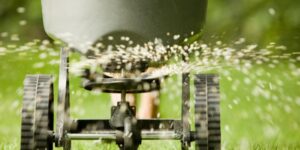 It also helps to apply a starter fertilizer after seeding and of course to water regularly to keep your soil/seed moist. The grass seed available here at Tim Wallace Landscape Supply is specially blended to match your lawn’s sunlight conditions: sunny, sun and shade, and super shady areas. The right seed blend enhances the overall look and long-term health of your lawn.
It also helps to apply a starter fertilizer after seeding and of course to water regularly to keep your soil/seed moist. The grass seed available here at Tim Wallace Landscape Supply is specially blended to match your lawn’s sunlight conditions: sunny, sun and shade, and super shady areas. The right seed blend enhances the overall look and long-term health of your lawn.
Do not apply conventional crabgrass control products before or after reseeding, as they will prevent your new seed from germinating. As for broadleaf weeds, such as dandelions and clover, you need to wait until the grass has germinated and been mowed three times before applying that type of product.
Your Local Topdressing Supplier: Contact Us Today
Tim Wallace Landscape Supply provides you with the knowledge and materials for a rich, healthy, colorful lawn and garden. We’re always interested in learning about your project and answering any questions you might have. To find out more about our 50/50 topsoil and sand topdressing, just give us a call at (630) 759-1080.


